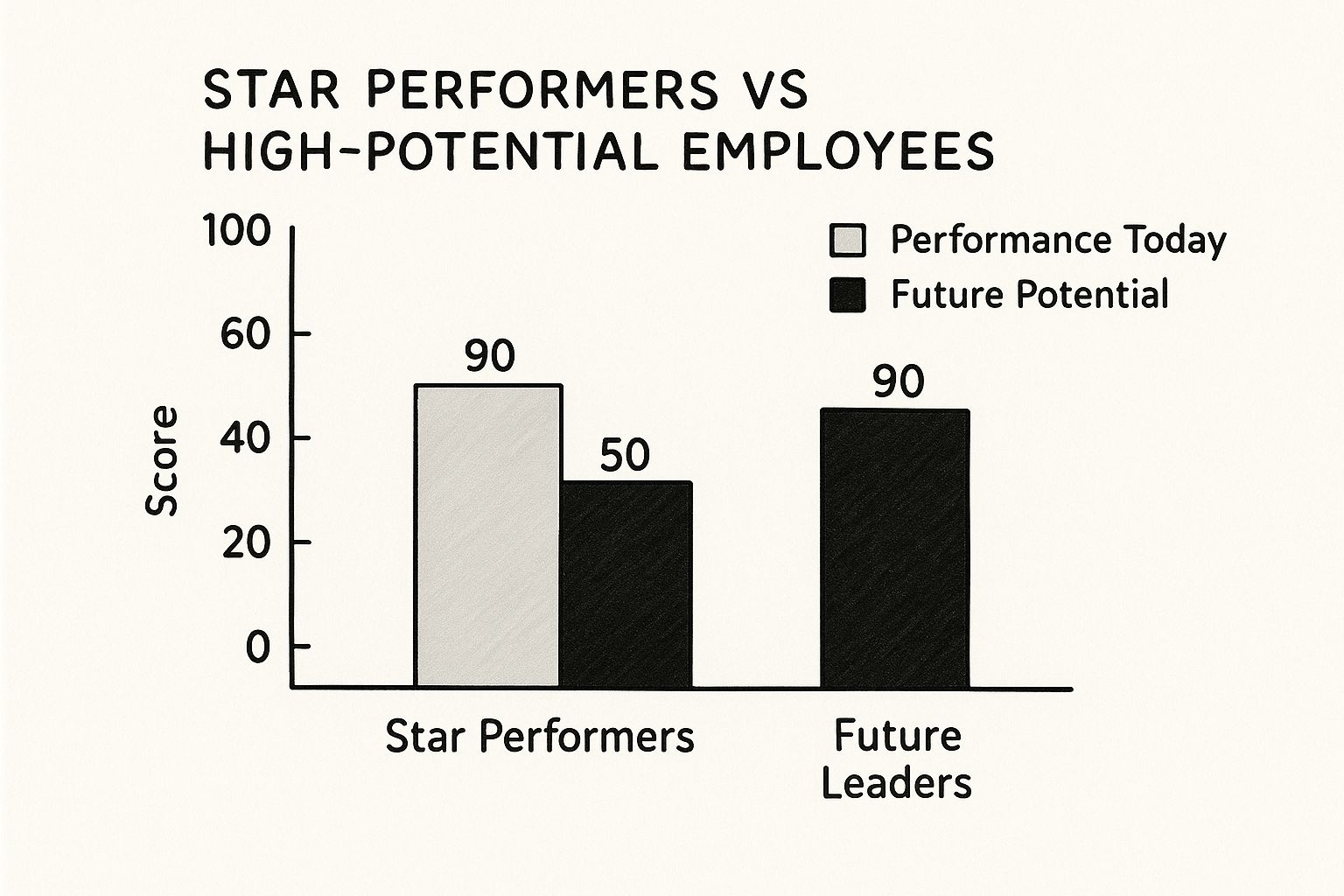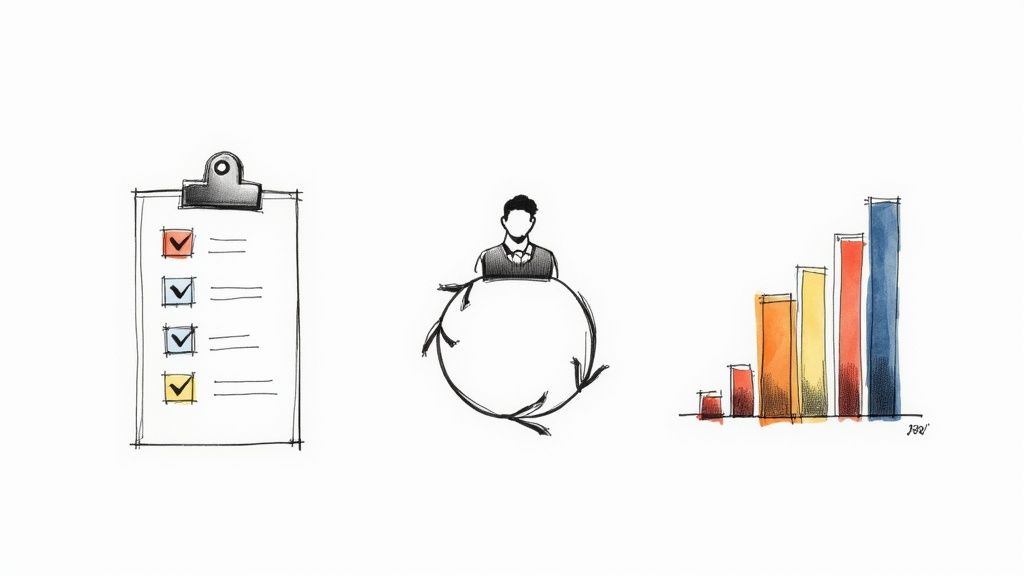How to Identify High Potential Employees

Spotting your next generation of leaders means looking past today's scorecards and tuning into the subtle indicators of future potential. It’s not just about what an employee accomplishes in their current role, but how they can grow and scale that impact across the entire organization down the road. This shift in perspective is the absolute key to building a leadership pipeline that lasts.
Rethinking Talent Spotting Beyond High Performance
It's one of the most common traps managers fall into: confusing top performers with high-potential employees (HiPos). They aren't the same thing, though there's often overlap.
Think of it this way: a high performer is someone who knocks their current job out of the park. A high-potential employee, on the other hand, shows the raw ability to succeed in much bigger, more complex roles in the future. Understanding this difference is crucial if you want to build a strong bench of future leaders.
When you don't have a clear way to spot potential, the default is to simply promote your most productive team member. This is how you end up with the classic "Peter Principle"—a fantastic engineer becomes a miserable manager, and suddenly, both their performance and their team's morale take a nosedive.
The Performer vs. Potential Distinction
So, how do you tell them apart? Your high performers are masters of their craft. They consistently crush their goals and know their role inside and out. Your HiPos, however, are wired a little differently. They show the drive, the learning agility, and the desire to tackle completely new challenges—and they have a knack for bringing others along with them.
To get this right, you need a system. Relying on gut feelings is a recipe for bias. In fact, smart companies are getting more structured about this. A 2024 report by the Talent Strategy Group found that about 57% of companies now have a formal process for identifying their high potentials, a figure that jumps to 72% in larger organizations.
Getting a handle on this distinction is the first step. You can dig deeper into the data behind these talent management trends and their impact to see how other companies are approaching it.
This visual really brings the concept to life, showing how today's stars differ from tomorrow's leaders.

You can see that while the star performer's current performance is off the charts, their potential for future growth is much more limited compared to a true HiPo.
To make this even clearer, let's break down some of the key differences in a simple table.
High Performer vs. High Potential Key Differentiators
This table highlights the core traits that separate someone who is great at their job today from someone who is destined for leadership tomorrow.
| Attribute | High Performer | High Potential Employee (HiPo) |
|---|---|---|
| Focus | Masters their current role and meets targets. | Thinks about future business needs and growth. |
| Ambition | Seeks recognition for their current achievements. | Aspires to take on greater responsibility and impact. |
| Skillset | Deep expertise in their specific function. | Broad skills and an ability to learn quickly. |
| Impact | Raises their own performance and productivity. | Elevates the performance of those around them. |
Looking at them side-by-side, the contrast becomes obvious. High performers add value; high potentials multiply it.
The critical takeaway is this: High performance is a prerequisite for high potential, but it is not a guarantee. Identifying true HiPos means looking for the raw ingredients of leadership—curiosity, resilience, and influence—not just impressive output.
Observing the Core Traits of Future Leaders

To find your next generation of leaders, you have to look past the performance reviews. The real clues are in the subtle, everyday behaviors that signal someone has what it takes to lead. It’s about how they handle a tough project, work with their teammates, and push themselves to get better.
We're looking for the person who not only crushes their own goals but also makes everyone around them better. Lots of people can excel in their current job, but a true high-potential employee (HiPo) shows the makings of a leader long before they have the title.
Drive and Motivation
One of the clearest signs of a HiPo is an internal fire that goes way beyond their job description. They aren't just checking off boxes; they’re actively hunting for problems to solve and ways to make things better. This kind of proactive ownership is a dead giveaway.
For instance, consider the employee at a software company who, noticing inefficiencies in the bug-tracking workflow, spends their own time developing a streamlined script to automate parts of the process. This initiative saves the team hours each week, even though it wasn't part of their assigned tasks. They are driven by a desire to improve the company's success, not just their own to-do list.
Keep an eye out for those who are constantly setting actionable goals for personal development at work. Their ambition isn't just for themselves; it's channeled into pushing the entire organization forward.
Learning Agility and Curiosity
Business is always changing, and your future leaders have to be able to keep up. Learning agility—the skill of picking up new things, dropping old habits, and relearning on the fly—is absolutely essential. It’s fueled by a genuine curiosity that keeps them growing.
These are the employees who jump at the chance to test new software, ask the tough "why" questions in meetings, or volunteer for cross-departmental projects to see the bigger picture. They don’t just tolerate ambiguity; they thrive in it, viewing unexpected hurdles as chances to learn, not as roadblocks.
A key behavior to watch for is how an individual reacts to feedback. A HiPo doesn't just accept constructive criticism; they actively solicit it. They understand that feedback is essential for growth and demonstrate a genuine desire to improve.
Peer Influence and Collaboration
Leadership potential often reveals itself most clearly in how someone works with their peers. Even without any formal authority, HiPos have a natural knack for inspiring and influencing the people around them. They build rock-solid relationships grounded in trust and mutual respect.
Pay attention to who the team naturally gravitates toward when they're stuck or need advice. It’s almost always the informal leader who is a great communicator, can navigate disagreements, and makes everyone want to work together. Their impact is a multiplier, lifting the skills of the whole group.
It's also important to remember that leadership isn't one-size-fits-all. Recognizing the different ways people lead is vital, as there are many different leadership personality types that can be effective.
Spotting these three core traits in the wild gives you a far more reliable way to identify your future leaders than just looking at performance data. These are the foundational behaviors that real leadership is built on.
Using Data-Driven Tools to Spot Your Next Leaders

Let's be honest, relying on "gut feelings" to find your next leaders is a recipe for bias. We all have them. To build a truly fair and effective talent pipeline, you have to look beyond your own subjective lens and get objective data into the mix.
This is about creating a level playing field. A data-driven approach helps you see the hidden strengths that don't always show up in day-to-day work. It gives you a consistent benchmark, ensuring everyone is measured by the same stick.
Start with Standardized Assessments
The first step in taking out the guesswork is to use scientifically validated assessment tools. These aren't just personality quizzes; they're designed to measure the core traits and cognitive abilities that are proven predictors of leadership success.
This is how you look past someone's current performance and get a real glimpse of their future capabilities.
Tools like the High Potential Trait Indicator (HPTI) from SHL or various emotional intelligence (EQ) scorecards are great for this. They dig into the essential stuff—ambition, curiosity, adjustment, and interpersonal skills. When you pair these results with feedback from their peers, you get a much fuller picture of an employee's potential.
You can learn more about the power of high-potential employee identification on huntscanlon.com to see how others are approaching this. The goal isn’t just to see if they get the right answers, but to understand how they think, solve problems, and deal with pressure.
Get the Full Story with 360-Degree Feedback
Individual assessments are powerful, but they’re just one piece of the puzzle. To see the whole person, you need input from the people who work with them every single day. That's where 360-degree feedback comes in.
This process gathers confidential, anonymous feedback from an employee's direct reports, peers, and managers. It’s the best way to get a real look at their collaboration style, communication skills, and ability to influence others—qualities that are almost impossible to judge accurately from the top down.
Consider a manager who perceives an employee as a quiet, heads-down worker. The 360-degree feedback could reveal that their peers see them as the team's go-to problem-solver and an informal leader. This data uncovers a level of influence the manager would have otherwise missed, highlighting the employee's potential for a formal leadership role. This kind of discrepancy is common and illustrates the value of multiple perspectives.
Don't underestimate the power of peer perception. It's often the most accurate predictor of how someone will lead. If an individual can inspire and motivate their colleagues without formal authority, they have a foundational leadership skill that can be built upon.
Dig Deeper with Structured Behavioral Interviews
When you're seriously considering someone for a bigger role, a standard Q&A session just won't do. You need to use structured behavioral interviews, which are specifically designed to uncover how a person has actually behaved in past situations.
Why? Because past behavior is one of the most reliable predictors of future behavior.
Instead of asking a hypothetical question like, "How would you handle a team conflict?" you get specific. Ask them to describe a real one: "Tell me about a time you disagreed with a teammate on an important project. What was the situation, what specific steps did you take to resolve it, and what was the outcome?"
This forces them to move beyond canned answers and provide concrete examples of their problem-solving skills, resilience, and emotional intelligence. To really nail this process, take a look at our complete guide on behavioral assessment tests.
By combining these different data points—assessments, 360-degree feedback, and behavioral interviews—you build a robust system that identifies genuine potential with far greater accuracy and fairness.
Building a Culture That Nurtures Potential

Pinpointing your high-potential employees is a huge win, but it’s really only half the battle. The real challenge—and where many organizations stumble—is creating an environment where that potential can actually be realized. Without a supportive culture, your rising stars will eventually start looking for growth opportunities somewhere else.
A visible, top-down commitment to professional growth is probably the single most important factor here. It sends a clear signal to your HiPos that you see their future with the company and are willing to invest in their journey. This creates a magnetic culture that not only keeps your best people but also attracts new talent looking for a place to thrive.
After all, your most ambitious people are hungry for growth. Organizations that genuinely prioritize mentorship, workshops, and leadership training create a space where these employees can succeed in senior roles and stay engaged for the long haul. You can discover more about what science says about identifying high-potential employees on hbr.org to dive deeper into the research.
Forge Clear Career Pathways
Vague promises of "future opportunities" just won't cut it for driven people. High-potential employees need to see a clear, tangible path forward. This means sitting down with them and actually mapping out what their career progression could look like inside your organization.
This goes beyond just pointing to a traditional career ladder. It should be a collaborative effort to define the specific skills, experiences, and milestones they'll need to hit to reach the next level. That kind of transparency removes uncertainty and gives them a concrete roadmap to follow, which is a powerful motivator.
Establish Meaningful Mentorship and Coaching
Connecting your HiPos with seasoned leaders is one of the most powerful development tools you have. A solid mentorship program provides the kind of guidance, support, and institutional knowledge that you just can't get from a formal training session.
A few evidence-based approaches work particularly well:
- Formal Mentorship: Pair HiPos with senior leaders outside their direct chain of command. This allows for more confidential, big-picture career coaching.
- Executive Coaching: For those right on the cusp of senior leadership, bringing in an external coach can offer objective feedback and help them navigate complex business challenges.
- Peer Coaching: Don't underestimate the power of peers. Creating small groups of HiPos lets them support each other, share what they’re learning, and solve problems together.
This kind of layered support system accelerates their growth and deepens their roots within the company.
The goal of mentorship isn't just to transfer knowledge; it's to build confidence. When a respected leader invests their time in a high-potential employee, it sends a powerful message that the organization believes in their future.
Provide Targeted Development Opportunities
Real growth happens when people are stretched beyond their comfort zones. Instead of relying only on classroom-style training, give them hands-on experiences that push them to develop new skills. Stretch assignments are perfect for this.
For example, asking a promising project manager to lead a high-stakes, cross-functional initiative forces them to practice influencing without direct authority and to think strategically about the entire business, not just their own department. This is a classic method used by companies like General Electric, which has a long history of rotating high-potentials through various business units and challenging roles to build broad leadership capabilities.
These real-world challenges are the crucibles where true leaders are forged. Ultimately, these practices are core to building a culture of excellence that empowers everyone, not just your top performers.
Building a Sustainable HiPo Identification System
Spotting your top talent isn't a one-and-done project. It has to be an ongoing, repeatable process baked into how your organization operates. If you don't have a structured approach, your efforts will be random and inconsistent, and you’ll never build a reliable leadership pipeline. The real goal here is to create a living, data-informed system that continuously surfaces your next generation of leaders.
A sustainable system is all about moving beyond a single snapshot or assessment. You need to be tracking key metrics over time. This data is crucial—it not only confirms you're backing the right people but also proves the program's value to senior leadership by connecting talent initiatives to actual business results.
Tracking the Right HiPo Program Metrics
So, how do you know if your identification efforts are actually working? You have to track specific data points. These metrics paint a clear picture of whether your program is delivering a real return on investment or just spinning its wheels.
Start with these core indicators:
- Promotion Velocity: Take a look at how quickly your identified HiPos are moving up compared to everyone else. A faster-than-average promotion rate is one of the strongest signals that you're picking the right people.
- Retention Rates: What percentage of your HiPo pool sticks around year after year? Research from Gartner shows that high-potential employees are often a high flight risk, making retention a critical metric.
- Performance in New Roles: This is the ultimate test. When your HiPos get promoted, are they meeting or blowing past expectations in the first 12-18 months? Success in a new, more demanding role validates their potential like nothing else.
For any of this to work long-term, your HiPo identification system must be woven into your broader effective workforce development strategies. This alignment ensures the skills you're spotting today are the ones you'll desperately need tomorrow.
Visualizing Your Talent with the 9-Box Grid
One of the most powerful and practical tools for managing a HiPo program is the 9-box grid. It’s a simple but brilliant matrix that helps you map out your entire talent landscape by plotting employees on two axes: their current performance and their future potential.
Typically, the vertical axis tracks leadership potential and the horizontal axis measures current job performance. This layout creates nine distinct boxes, giving you a clear, visual way to categorize talent and tailor development plans.
The real magic of the 9-box grid is that it forces a structured, honest conversation about talent. It shifts the discussion from gut feelings and subjective opinions to a shared, objective framework, making succession planning far more strategic and less vulnerable to bias.
For instance, someone who lands in that top-right box (high performance, high potential) is a future leader you need to invest in right now with stretch assignments and visibility. On the other hand, an employee in the bottom-right (high performance, low potential) is a rock-solid contributor. They should absolutely be rewarded in their current role, but they might not be the right fit for a leadership track.
This visual approach is a cornerstone of any good strategy for integrated talent management because it directly links identification with development and succession planning. It helps you instantly see where your bench strength is, spot critical talent gaps, and make smarter bets on who to invest in. That’s how you build a truly sustainable system for growing your own leaders.
Answering Your Questions About High-Potential Programs
Even with the best framework in place, putting a high-potential (HiPo) program into practice always brings up a few questions. Let's tackle some of the most common ones from managers and leaders.
How Often Should We Assess for High Potential?
Spotting potential isn’t a one-and-done deal. It needs to be woven into your regular talent review cycle. If you only look at it once, you get a single snapshot in time, which can totally misrepresent someone’s career trajectory.
You should be having formal discussions at least annually, but semi-annual check-ins are even better. This rhythm lets you see how an employee is growing over time and spot emerging talent you might have missed before. It also gives you the flexibility to adjust development plans as your company's needs evolve, keeping your talent pipeline dynamic and relevant.
What Are the Biggest Mistakes to Avoid When Identifying HiPos?
It’s surprisingly easy to fall into a few common traps when trying to figure out who has star potential. Just knowing what they are is half the battle.
Based on extensive research in talent management, these are three of the biggest pitfalls:
- Mistaking performance for potential: We've talked about this, but it bears repeating. Someone crushing it in their current role won't automatically be a great leader. It’s a different skill set.
- Using inconsistent criteria: If your engineering department is looking for one thing and marketing is looking for something else entirely, your process is broken and unfair.
- Falling for the 'like-me' bias: We all do it. We naturally gravitate toward people who think and act like we do. Managers can unconsciously favor employees who mirror their own styles.
The only way to combat these biases is to ground your entire process in objective data and a standardized framework. Using validated assessments and the same behavioral indicators across every single department is the key to building a fair and effective system.
Can an Employee's High-Potential Status Change?
Absolutely. In fact, it should. High potential isn't a permanent label. It’s fluid. Someone’s potential can change based on their own career goals, a shift in their performance, or the company suddenly needing a different kind of leader.
Think about it: someone might show incredible promise early on, only to realize they’re happiest as a deep subject matter expert. On the flip side, a quiet, steady performer might take the lead on a tough project and suddenly reveal a new level of strategic thinking and ambition you never saw before.
A truly effective HiPo program is built for this. It has regular check-ins and reassessments baked right in, ensuring the "HiPo" designation stays accurate and aligns with what the individual and the company need.
Ready to build a stronger, more value-aligned team? MyCulture.ai provides the science-backed assessment tools you need to identify candidates and employees who truly fit your culture. Discover how to make data-driven hiring decisions today.